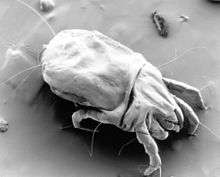Dust mite allergy
Dust mite allergy, also known as house dust allergy, is a sensitization and allergic reaction to the droppings of house dust mites. The allergy is common[1][2] and can trigger allergic reactions such as asthma, eczema or itching. It is the manifestation of a parasitosis. The mite's gut contains potent digestive enzymes (notably Peptidase 1) that persist in their feces and are major inducers of allergic reactions such as wheezing. The mite's exoskeleton can also contribute to allergic reactions. Unlike scabies mites or skin follicle mites, house dust mites do not burrow under the skin and are not parasitic.[3]
| Dust Mite Allergy | |
|---|---|
| Other names | House dust allergy |
| Specialty | Emergency medicine |
| Symptoms | Symptoms |
| Causes | Mite droppings |
| Treatment | Cutting down mite numbers |

The symptoms can be avoided or alleviated by a number of measures. In general, cutting down mite numbers may reduce these reactions while others say efforts to remove these mites from the environment have not been found to be effective.[4] Immunotherapy may be useful in those affected.[4] Subcutaneous injections have better evidence than under the tongue dosing.[5] Topical steroids as nasal spray or inhalation may be used.[6]
.jpg)
Severe dust mite infestation in the home has been linked to atopic dermatitis and epidermal barrier damage has been documented.[7]
Symptoms
Dust mite allergy symptoms caused by inflammation of nasal passages include:
- Cough
- Facial pressure and pain
- Itchy, red or watery eyes
- Itchy nose, roof of mouth or throat
- Nasal congestion
- Postnasal drip
- Runny nose
- Sneezing
- Swollen, blue-colored skin under your eyes
If the dust mite allergy contributes to asthma:
- Audible whistling or wheezing sound when exhaling
- Bouts of coughing or wheezing that are worsened by a respiratory virus such as a cold or the flu
- Chest tightness or pain
- Difficulty breathing
- Trouble sleeping caused by shortness of breath, coughing or wheezing[8][4][9]
References
- Alderman, Lesley (2011-03-04). "Who Should Worry About Dust Mites (and Who Shouldn't)". The New York Times. ISSN 0362-4331. Retrieved 2020-07-23.
- "Dust Mite Allergy" (PDF). NHS.
- Ogg, Barb. "Managing House Dust Mites" (PDF). Extension, Institute of Agriculture and Natural Resources, University of Nebraska–Lincoln. Retrieved 24 January 2019.
- Biagtan, M; Viswanathan, R; Bush, RK (December 2014). "Immunotherapy for house dust mite sensitivity: where are the knowledge gaps?". Current Allergy and Asthma Reports. 14 (12): 482. doi:10.1007/s11882-014-0482-0. PMC 5034865. PMID 25354663.
- Eifan, AO; Calderon, MA; Durham, SR (November 2013). "Allergen immunotherapy for house dust mite: clinical efficacy and immunological mechanisms in allergic rhinitis and asthma". Expert Opinion on Biological Therapy. 13 (11): 1543–56. doi:10.1517/14712598.2013.844226. PMID 24099116.
- Carrard, A; Pichler, C (April 2012). "[House dust mite allergy]". Therapeutische Umschau. 69 (4): 249–52. doi:10.1024/0040-5930/a000281. PMID 22477664.
- Cork, Michael J; Robinson, Darren A; Vasilopoulos, Yiannis; Ferguson, Adam; Moustafa, Manar; MacGowan, Alice; Duff, Gordon W; Ward, Simon J; Tazi-Ahnini, Rachid (2006). "New perspectives on epidermal barrier dysfunction in atopic dermatitis: Gene–environment interactions". Journal of Allergy and Clinical Immunology. 118 (1): 3–21, quiz 22–3. doi:10.1016/j.jaci.2006.04.042. PMID 16815133.
- "Dust mite allergy - Symptoms and causes". Mayo Clinic. Retrieved 2020-07-23.
- Lee, Young Ji; Han, Soo Jung; Lee, Hun; Kim, Jin Sun; Seo, Kyoung Yul (2016). "Development of Allergic Conjunctivitis Induced by House Dust Mite Extract FromDermatophagoides pteronyssinus". Investigative Ophthalmology & Visual Science. 57 (4): 1773–81. doi:10.1167/iovs.15-17340. ISSN 1552-5783. PMID 27074380.
Further reading
- List of mites associated with cutaneous reactions
- List of allergens
- House dust mite
- Allergy
- Asthma and Allergy Friendly